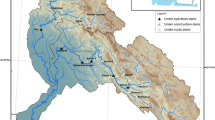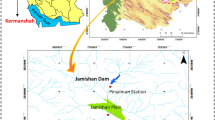Abstract
This paper evaluates the performances of the models that incorporate forecasting inflow for cascaded hydropower reservoirs operation. These models are constructed separately on the concepts of explicit stochastic optimization (ESO) and implicit stochastic optimization (ISO) as well as parameterization-simulation-optimization (PSO). Firstly, the aggregation-disaggregation method is implemented in ESO models to reduce the complexity of stochastic dynamic programming (SDP). And the aggregate flow SDP (AF-SDP) and aggregation-disaggregation SDP (AD-SDP) are constructed respectively. Secondly, in ISO model, decision tree is the well-known and widespread algorithm. The algorithm C 5.0 is selected to extract the if-then-else rules for reservoir operation. Thirdly, based on the PSO model, the hedging rule curves (HRCs) are pre-defined by fusing the storage and inflow as state variable. The parameters of the HRCs are determined by using the simulation-optimization model. Finally, China’s Hun River cascade hydropower reservoirs system is taken as an example to illustrate the efficiency and reliability of the models. In addition, the values of quantitative precipitation forecasts of the global forecast system (10 days lead-time) are implemented to forecast the 10 days inflow.
Similar content being viewed by others
References
Bravo1 J, Paz A, Collischonn W, et al. Incorporating forecasts of rainfall in two hydrologic models used for medium-range streamflow forecasting. J Hydrol Eng, 2009, 14: 435–445
Collischonn W, Haas R, Andreolli I, et al. Forecasting river Uruguay flow using rainfall forecasts from a regional weather-prediction model. J Hydrol, 2005, 305: 87–98
Collischonn W, Tucci C, Clarke R, et al. Medium-range reservoir inflow predictions based on quantitative precipitation forecasts. J Hydrol, 2007, 344: 112–122
Golding B W. Quantitative precipitation forecasting in the UK. J Hydrol, 2000, 239: 286–305
Habets F, LeMaigne P, Noilhan J. On the utility of operational precipitation forecasts to served as input for streamflow forecasting. J Hydrol, 2004, 293: 270–288
Peng Y, Wang G L, Tang G L, et al. Study on reservoir operation optimization of Ertan Hydropower Station considering GFS forecasted precipitation. Sci China Tech Sci, 2011, 54: 76–82
Celeste A B, Billib M. Evaluation of stochastic reservoir operation optimization models. Adv Water Resour, 2009, 32: 1429–1443
Simonovic S P. Reservoir systems analysis: closing gap between theory and practice. J Water Res Pl-ASCE, 1992, 118: 262–280
Wurbs R A. Reservoir-system simulation and optimization models. J Water Res Pl-ASCE, 1993, 119: 455–72
Teegavarapu R, Simonovic S P. Optimal operation of water resource systems: trade-offs between modeling and practical solutions. Integr Water Res Manage, IAHS Publ, 2001, 272: 257–263
Labadie J W. Optimal operation of multireservoir systems: State-of-the-art review. J Water Res Pl-ASCE, 2004, 130: 93–111
You J Y, Cai X. Hedging rule for reservoir operations: 1. A theoretical analysis. Water Resour Res, 2008, 44: W01415
Mujumdar P, Nirmala B. A bayesian stochastic optimization model for a multi-reservoir hydropower system. Water Resour Manage, 2007, 21: 1465–1485
Young G K. Finding reservoir operating rules. J Hydraul Div, 1967, 93: 297–321
Karamouz M, Houck M H. Annual and monthly reservoir operating rules generated by deterministic optimization. Water Resour Res, 1982, 18: 1337–1344
Kim T, Heo J H. Application of implicit stochastic optimization in the Han River basin. In: Proceedings of the fourth international conference on hydroscience and engineering. Seoul: Korean Society of Water Resources, 2000
Saad M, Turgeon A, Bigras P, et al. Learning disaggregation technique for the operation of long-term hydroelectric power systems. Water Resour Res, 1994, 30: 3195–3202
Chaves P, Kojiri T. Deriving reservoir operational strategies considering water quantity and quality objectives by stochastic fuzzy neural networks. Adv Water Resour, 2007, 30: 1329–1341
Wei C, Hsu N. Derived operating rules for a reservoir operation system: comparison of decision trees, neural decision trees and fuzzy decision trees. Water Resour Res, 2008, 44: W02428
Chandramouli V, Deka P. Neural network based decision support model for optimal reservoir operation. Water Resour Manage, 2005, 19: 447–464
Salvatore B, Simona C, Nello P, et al. Discovering reservoir operating rules by a rough set approach. Water Resour Manage, 2006, 20: 19–36
Liu P, Guo S, Xu X, et al. Derivation of aggregation-based joint operating rule curves for cascade hydropower reservoirs. Water Resour Manage, 2011, 25: 3177–3200
Wang X L, Cheng J H, Yin Z J, et al. A new approach of obtaining reservoir operation rules: Artificial immune recognition system. Expert Syst Appl, 2011, 38: 11701–11707
Moeini R, Afshar A, Afshar M H. Fuzzy rule-based model for hydropower reservoirs operation. Int J Electr Power Energy Syst, 2011, 33: 171–178
Chang F J, Chen L, Chang L C. Optimizing the reservoir operation rule curves by genetic algorithms. Hydrol Process, 2005, 19: 2277–2289
Tu M, Hsu N, Yeh W. Optimization of reservoir management and operation with hedging rules. J Water Res Pl-ASCE, 2003, 129: 86–97
Nalbantis I, Koutsoyiannis D. A parametric rule for planning and management of multiplereservoir systems. Water Resour Res, 1997, 33: 2165–2177
Oliveira R, Loucks D P. Operating rules for multi-reservoir systems. Water Resour Res, 1997, 33: 839–852
Neelakantan T, Pundarikanthan N. Neural network-based simulation-optimization model for reservoir operation. J Water Res Pl-ASCE, 2000, 126: 57–64
Koutsoyiannis D, Economou A. Evaluation of the parameterization-simulation-optimization approach for the control of reservoir systems. Water Resour Res, 2003, 39: 1170
Momtahen S, Dariane A B. Direct search approaches using genetic algorithms for optimization of water reservoir operating policies. J Water Res Pl-ASCE, 2007, 133: 202–209
Chen L. Real coded genetic algorithm optimization of long term reservoir operation. J Am Water Resour Assoc, 2003, 39: 1157–1165
Tung C, Hsu S, Liu C, et al. Application of the genetic algorithm for optimizing operation rules of the LiYuTan reservoir in Taiwan. J Am Water Resour Assoc, 2003, 39: 649–657
Guo X, Hu T, Zhang T, et al. Bilevel model for multi-reservoir operating policy in inter-basin water transfer-supply project. J Hydrol, 2012, 424–425: 252–263
Chaturvedi M C, Srivastava D K. Study of a complex water-resources system with screening and simulation-models. Water Resour Res, 1981, 17: 783–794
Kuo J, Hsu N, Chu W, et al. Real-time operation of Tanshui river reservoirs. J Water Res Pl-ASCE, 1990, 116: 349–361
Rani D, Moreira M M. Simulation-optimization modeling: a survey and potential application in reservoir systems operation. Water Resour Manage, 2010, 24: 1107–1138
Zhang H L, Li D X, Wang X K, et al. Quantitative evaluation of NEXRAD data and its application to the distributed hydrologic model BPCC. Sci China Tech Sci, 2012, 55: 2617–2624
Tang G, Zhou H, Li N, et al. Value of medium-range precipitation forecasts in inflow prediction and hydropower optimization. Water Resour Manage, 2010, 24: 2721–2742
Liang G, Xi S, Wang B. Ten-day correlation forecast model of rainfall and runoff based on BP neural network (in Chinese). Water Power, 2009, 35: 10–12
Wang G, Liang G, Lou L, et al. Study on GFS forecasted rainfall statistic and its feasibility in real time inter-basin water transfer system operation decision making (in Chinese). South to North Water Transf Water Sci Tech, 2010, 8: 58–60
Xi S, Wang B, Liang G, et al. Inter-basin water transfersupply model and risk analysis with consideration of rainfall forecast information. Sci China Tech Sci, 2010, 53: 3316–3323
Zhao R, Zhang Y, Fang L. The Xinanjiang model. In: Hydrological Forecasting Proceedings Oxford Symposium. Wallingford, U.K: IAHS Publication, 1980. 129: 351–356
Zhao R. The Xinanjiang model applied in China. J Hydrol, 1992, 135: 371–381
Turgeon A, Charbonneau R. An aggregation-disaggregation approach to long term reservoir management, Water Resour Res, 1998, 34: 3585–3594
Valdes J B, Montbrun J, Strzepek K M, et al. Aggregation-Disaggregation approach to multireservoir operation. J Water Res Pl-ASCE, 1992, 118: 423–444
Bessler F T, Savic D A, Walters G A. Water reservoir control with data mining. J Water Res Pl-ASCE, 2003, 129: 26–34
Quinlan J R. C4.5: Programs for Machine Learning. San Mateo: Morgan Kaufmann Publishers, 1993
Hashimoto T, Stedinger J R, Loucks D P. Reliability, resiliency and vulnerability criteria for water resources system performance evaluation. Water Resour Res, 1982, 18: 14–20
Author information
Authors and Affiliations
Corresponding author
Rights and permissions
About this article
Cite this article
Xu, W., Peng, Y. & Wang, B. Evaluation of optimization operation models for cascaded hydropower reservoirs to utilize medium range forecasting inflow. Sci. China Technol. Sci. 56, 2540–2552 (2013). https://doi.org/10.1007/s11431-013-5346-7
Received:
Accepted:
Published:
Issue Date:
DOI: https://doi.org/10.1007/s11431-013-5346-7




